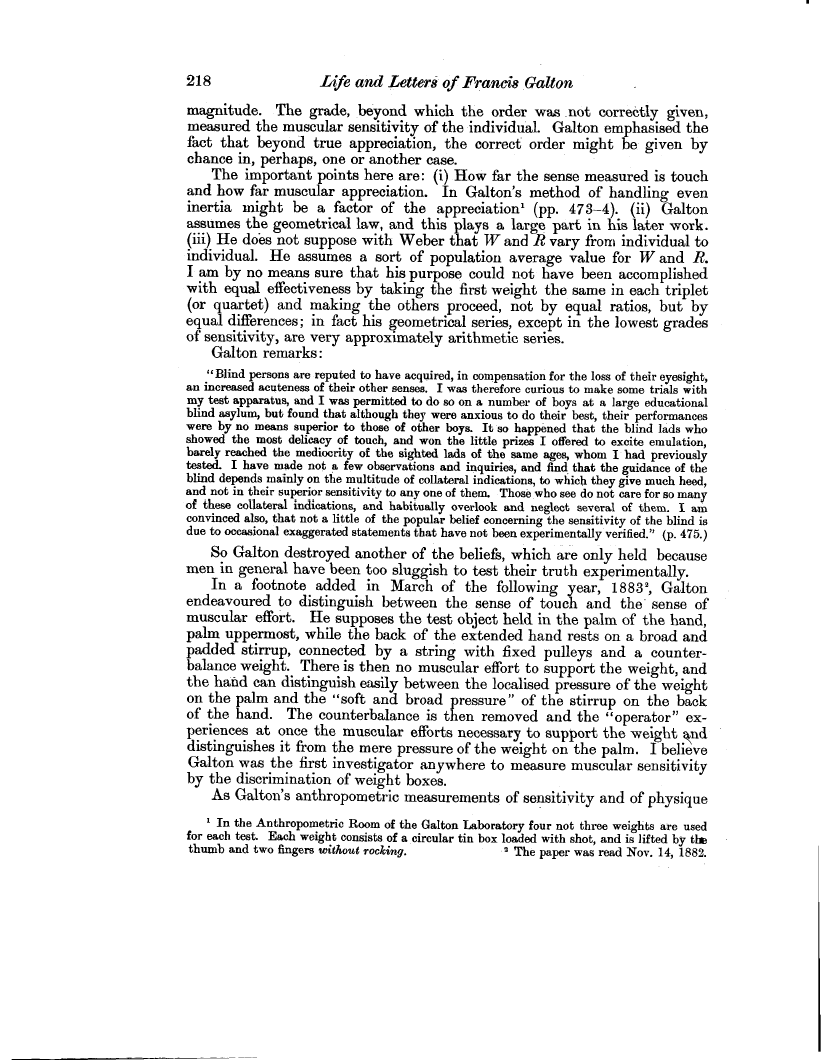218 Life and Letters of Francis Galton
magnitude. The grade, beyond which the order was .not correctly given, measured the muscular sensitivity of the individual. Galton emphasised the fact that beyond true appreciation, the correct order might be given by chance in, perhaps, one or another case.
The important points here are: (i) How far the sense measured is touch and how far muscular appreciation. In Galton's method of handling even inertia might be a factor of the appreciation' (pp. 473-4). (ii) Galton assumes the geometrical law, and this plays a large part in his later work. (iii) He does not suppose with Weber that W and R vary from individual to individual. He assumes a sort of population average value for W and R. I am by no means sure that his purpose could not have been accomplished with equal effectiveness by taking the first weight the same in each triplet (or quartet) and making the others proceed, not by equal ratios, but by equal differences; in fact his geometrical series, except in the lowest grades of sensitivity, are very approximately arithmetic series.
Galton remarks
"Blind persons are reputed to have acquired, in compensation for the loss of their eyesight, an increased acuteness of their other senses. I was therefore curious to make some trials with my test apparatus, and I was permitted to do so on a number of boys at a large educational
blind asylum, but found that although they were anxious to do their best, their performances were by no means superior to those of other boys. It so happened that the blind lads who showed the most delicacy of touch, and won the little prizes I offered to excite emulation, barely reached the mediocrity of the sighted lads of the same ages, whom I had previously tested. I have made not a few observations and inquiries, and find that the guidance of the blind depends mainly on the multitude of collateral indications, to which they give much heed, and not in their superior sensitivity to any one of them. Those who see do not care for so many of these collateral indications, and habitually overlook and neglect several of them. I am convinced also, that not a little of the popular belief concerning the sensitivity of the blind is
due to occasional exaggerated statements that have not been experimentally verified." (p. 475.)
So Galton destroyed another of the beliefs, which are only held because men in general have been too sluggish to test their truth experimentally.
In a footnote added in March of the following year, 18832, Galton endeavoured to distinguish between the sense of touch and the' sense of muscular effort. He supposes the test object held in the palm of the hand, palm uppermost, while the back of the extended hand rests on a broad and padded stirrup, connected by a string with fixed pulleys and a counterbalance weight. There is then no muscular effort to support the weight, and the hand can distinguish easily between the localised pressure of the weight on the palm and the "soft and broad pressure" of the stirrup on the back of the hand. The counterbalance is then removed and the "operator" experiences at once the muscular efforts necessary to support the weight end distinguishes it from the mere pressure of the weight on the palm. I believe Galton was the first investigator anywhere to measure muscular sensitivity by the discrimination of weight boxes.
As Galton's anthropometric measurements of sensitivity and of physique
' In the Anthropometric Room of the Galton Laboratory four not three weights are used for each test. Each weight consists of a circular tin box loaded with shot, and is lifted by the thumb and two fingers without rocking. 2 The paper was read Nov. 14, 1882.

